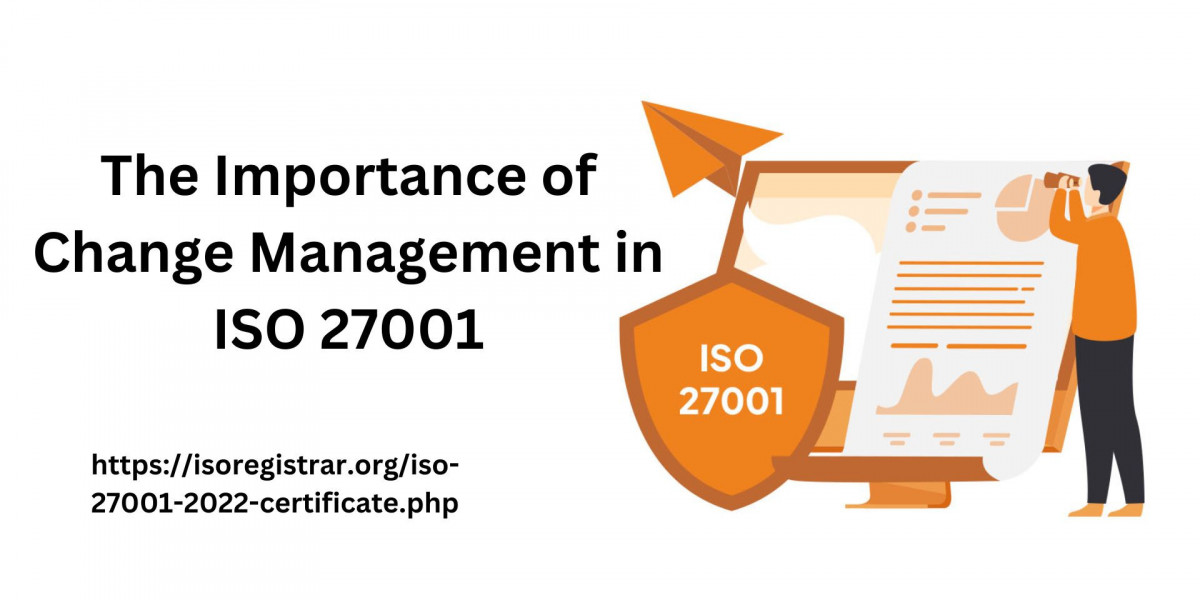In todays fast-paced digital environment, organizations face constant changesbe it in technology, regulations, or internal processes. For businesses adhering to ISO 27001 certification, which establishes a framework for an Information Security Management System (ISMS), effective change management is critical. This article delves into the significance of change management within the context of ISO 27001, exploring its benefits, key components, and best practices.
Understanding ISO 27001 and Change Management
ISO 27001 is an international standard that provides a systematic approach to managing sensitive information. The standard emphasizes the need for a structured ISMS that includes risk management, compliance, and continuous improvement. Change management, in this context, refers to the process of overseeing and implementing changes to the ISMS in a controlled manner to minimize disruptions and ensure ongoing security.
The Need for Change Management
Change is inevitable. Whether it's new technology, shifting regulations, or changes in organizational structure, every business transforms. In an ISMS, these changes can impact security controls, risk assessments, and compliance with ISO 27001 requirements. Without a structured change management process, organizations risk introducing vulnerabilities, failing to comply with regulations, or disrupting business operations.
Benefits of Change Management in ISO 27001
1. Enhanced Security Posture
A robust change management process helps ensure that all modifications to the ISMS are evaluated for their potential impact on information security. By systematically assessing changes, organizations can identify and mitigate risks, thereby enhancing their overall security posture. This proactive approach helps prevent security incidents that could arise from unregulated changes.
2. Compliance Assurance
ISO 27001 mandates compliance with various legal and regulatory requirements. Change management ensures that any alterations to systems, processes, or policies are documented and assessed for compliance with these obligations. This diligence minimizes the risk of non-compliance and the associated penalties, safeguarding the organizations reputation.
3. Improved Risk Management
Effective change management incorporates risk assessment as a core component. Each change is evaluated for its potential risks, enabling organizations to make informed decisions about whether to proceed. This systematic evaluation fosters a culture of risk awareness and ensures that risk mitigation strategies are applied consistently across the organization.
4. Streamlined Processes
Change management introduces a structured approach to handling modifications. By establishing clear procedures for proposing, assessing, and implementing changes, organizations can reduce confusion and streamline processes. This efficiency translates to quicker response times and smoother transitions, which are vital in a dynamic business environment.
5. Increased Stakeholder Engagement
When changes are managed effectively, stakeholders are more likely to be informed and engaged. This engagement fosters a sense of ownership and accountability among employees, which is essential for the successful implementation of changes. Additionally, keeping stakeholders informed helps mitigate resistance to change, ensuring smoother transitions.
Key Components of Change Management in ISO 27001
1. Change Identification
The first step in change management involves identifying the need for change. This could stem from various sources, such as technological advancements, security vulnerabilities, or shifts in regulatory requirements. A well-defined process for identifying changes helps ensure that no critical adjustments are overlooked.
2. Change Assessment
Once a change is identified, it must be assessed for its potential impact on the ISMS. This assessment involves evaluating risks, compliance implications, and the resources required for implementation. Engaging relevant stakeholders in this process ensures that all perspectives are considered, leading to more informed decision-making.
3. Change Approval
After assessment, the proposed change must receive formal approval before implementation. Establishing a change approval board or committee can facilitate this process, ensuring that changes align with organizational objectives and do not compromise information security.
4. Change Implementation
Once approved, the change can be implemented. This stage should be carefully planned, with clear communication to all stakeholders about the nature of the change, its benefits, and any actions required on their part. Effective training and support during this phase are crucial to ensuring that employees understand and adapt to the changes.
5. Change Review
Post-implementation, it is essential to review the change to evaluate its effectiveness. This review process should assess whether the change achieved its intended outcomes and whether any unforeseen issues arose. Feedback from stakeholders can provide valuable insights that inform future change management efforts.
6. Documentation and Reporting
Documentation is a cornerstone of effective change management. Every change should be recorded, including the rationale behind it, the assessment process, and the outcomes. This documentation not only supports compliance with ISO 27001 but also serves as a valuable resource for future reference.
Best Practices for Effective Change Management
1. Foster a Change Management Culture
Creating a culture that embraces change is vital. Encourage employees to view change as an opportunity for growth and improvement rather than a disruption. Leadership should model positive attitudes toward change and actively support initiatives that promote change management.
2. Provide Training and Resources
Investing in training programs that educate employees about change management principles and processes is essential. Equipping staff with the knowledge and tools to navigate changes will enhance their confidence and capability, leading to more successful implementations.
3. Communicate Effectively
Transparent and open communication is key to successful change management. Keep stakeholders informed throughout the change process, addressing concerns and soliciting feedback. Effective communication helps build trust and minimizes resistance to change.
4. Utilize Change Management Tools
Implementing change management tools can streamline the process and improve collaboration. Various software solutions are available that facilitate change requests, assessments, approvals, and documentation, making it easier to manage changes systematically.
5. Monitor and Adapt
Change management is not a one-time effort; it requires ongoing monitoring and adaptation. Regularly review change management processes to identify areas for improvement. Being responsive to feedback and evolving organizational needs will enhance the effectiveness of change management efforts.
Process of iso certification
Step 1: Go to the website for ISO Certification.
Step 2: Complete and submit.
After completing the ISO Certification Registration Form, submit the form.
Step 3: A payment received option shows after submission; you must pay the fee to continue.
Step 4: After making the payment, you will upload the files needed for the next steps.
Step 5: After that, our executive will call you for further process. regarding form.
Step 6: Your ISO certificate will be sent to the registered email address within 5 to 7 business days.
Note: You can apply for ISO 9001 Certificate for quality management system
Conclusion
Change management is a critical component of ISO 27001 implementation and maintenance. As organizations navigate the complexities of an ever-evolving digital landscape, the need for structured change management processes becomes increasingly vital. By effectively managing changes to the ISMS, organizations can enhance their security posture, ensure compliance, and foster a culture of continuous improvement.
Investing in change management not only protects sensitive information but also positions businesses for long-term success. In a world where change is constant, organizations that embrace effective change management practices will be better equipped to thrive in the face of challenges and seize new opportunities.








